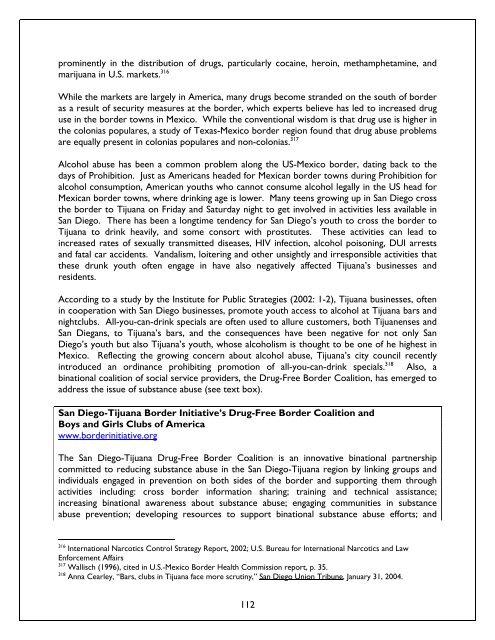Blurred Borders - International Community Foundation
Blurred Borders - International Community Foundation
Blurred Borders - International Community Foundation
Create successful ePaper yourself
Turn your PDF publications into a flip-book with our unique Google optimized e-Paper software.
prominently in the distribution of drugs, particularly cocaine, heroin, methamphetamine, and<br />
marijuana in U.S. markets. 316<br />
While the markets are largely in America, many drugs become stranded on the south of border<br />
as a result of security measures at the border, which experts believe has led to increased drug<br />
use in the border towns in Mexico. While the conventional wisdom is that drug use is higher in<br />
the colonias populares, a study of Texas-Mexico border region found that drug abuse problems<br />
are equally present in colonias populares and non-colonias. 317<br />
Alcohol abuse has been a common problem along the US-Mexico border, dating back to the<br />
days of Prohibition. Just as Americans headed for Mexican border towns during Prohibition for<br />
alcohol consumption, American youths who cannot consume alcohol legally in the US head for<br />
Mexican border towns, where drinking age is lower. Many teens growing up in San Diego cross<br />
the border to Tijuana on Friday and Saturday night to get involved in activities less available in<br />
San Diego. There has been a longtime tendency for San Diego’s youth to cross the border to<br />
Tijuana to drink heavily, and some consort with prostitutes. These activities can lead to<br />
increased rates of sexually transmitted diseases, HIV infection, alcohol poisoning, DUI arrests<br />
and fatal car accidents. Vandalism, loitering and other unsightly and irresponsible activities that<br />
these drunk youth often engage in have also negatively affected Tijuana’s businesses and<br />
residents.<br />
According to a study by the Institute for Public Strategies (2002: 1-2), Tijuana businesses, often<br />
in cooperation with San Diego businesses, promote youth access to alcohol at Tijuana bars and<br />
nightclubs. All-you-can-drink specials are often used to allure customers, both Tijuanenses and<br />
San Diegans, to Tijuana’s bars, and the consequences have been negative for not only San<br />
Diego’s youth but also Tijuana’s youth, whose alcoholism is thought to be one of he highest in<br />
Mexico. Reflecting the growing concern about alcohol abuse, Tijuana’s city council recently<br />
introduced an ordinance prohibiting promotion of all-you-can-drink specials. 318 Also, a<br />
binational coalition of social service providers, the Drug-Free Border Coalition, has emerged to<br />
address the issue of substance abuse (see text box).<br />
San Diego-Tijuana Border Initiative’s Drug-Free Border Coalition and<br />
Boys and Girls Clubs of America<br />
www.borderinitiative.org<br />
The San Diego-Tijuana Drug-Free Border Coalition is an innovative binational partnership<br />
committed to reducing substance abuse in the San Diego-Tijuana region by linking groups and<br />
individuals engaged in prevention on both sides of the border and supporting them through<br />
activities including: cross border information sharing; training and technical assistance;<br />
increasing binational awareness about substance abuse; engaging communities in substance<br />
abuse prevention; developing resources to support binational substance abuse efforts; and<br />
316<br />
<strong>International</strong> Narcotics Control Strategy Report, 2002; U.S. Bureau for <strong>International</strong> Narcotics and Law<br />
Enforcement Affairs<br />
317<br />
Wallisch (1996), cited in U.S.-Mexico Border Health Commission report, p. 35.<br />
318<br />
Anna Cearley, “Bars, clubs in Tijuana face more scrutiny,” San Diego Union Tribune, January 31, 2004.<br />
112















